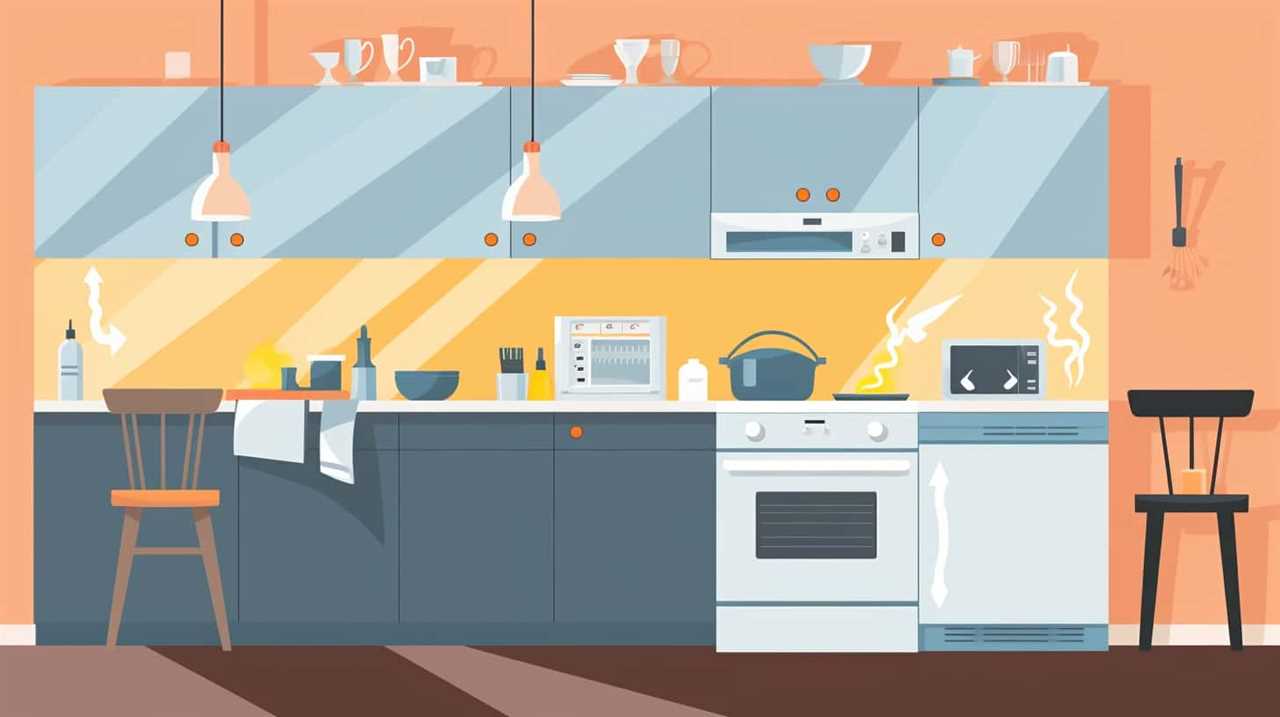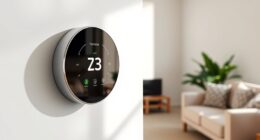Proper kitchen lighting enhances your safety by reducing shadows, brightening workspaces, and preventing accidents like cuts or burns. It helps you see clearly when chopping, measuring, or handling hot items, making your tasks quicker and more accurate. Good lighting also allows you to spot spills or spoiled ingredients easily. To maximize safety and efficiency, thoughtful placement and energy-efficient choices matter. Keep exploring to discover how to make your kitchen both safer and more efficient with the right lighting setup.
Key Takeaways
- Proper lighting reduces accidents by improving visibility during food prep and handling hot or sharp objects.
- Strategic placement of task and under-cabinet lighting enhances safety and prevents shadows that cause mishaps.
- Energy-efficient lighting solutions, like LEDs and motion sensors, lower costs while ensuring consistent illumination for safety.
- Adequate lighting helps quickly locate safety tools and emergency exits, improving emergency response times.
- Well-designed lighting increases work accuracy and efficiency, reducing errors and promoting eco-friendly energy use.

Good lighting in your kitchen is vital for both safety and efficiency. When your workspace is well-lit, you can prevent accidents like cuts, burns, or trips. Proper lighting ensures you see clearly while chopping, measuring, or handling hot items, reducing the risk of injuries. It also makes it easier to identify spoiled ingredients or check for cleanliness, promoting a safer cooking environment. Beyond immediate safety, good lighting supports emergency preparedness by allowing you to quickly locate fire extinguishers, first aid supplies, or emergency exits during unexpected situations. When your kitchen is well illuminated, you’re better equipped to respond swiftly, minimizing potential harm. Incorporating innovative AI-powered solutions in smart lighting systems can further optimize energy use and enhance safety features. Energy conservation plays an important role when considering your kitchen lighting. Choosing energy-efficient bulbs, such as LEDs, not only reduces your electricity bills but also aligns with eco-friendly practices. These bulbs consume less power while providing bright, consistent light, which is vital for maintaining safety and efficiency. Installing dimmers or motion sensors can further enhance energy savings by ensuring lights are only on when needed, especially during off-peak times or when the kitchen isn’t in use. Proper placement of lighting fixtures also helps distribute light evenly across your workspace, reducing the need for additional lighting sources and preventing wastage. In terms of safety, bright, well-placed lighting minimizes shadows and dark corners where accidents can happen. For example, under-cabinet lighting illuminates countertops, making it easier to see what you’re doing and avoid mishaps. Task lighting, especially over stove tops and sinks, ensures you have focused illumination exactly where you need it. This not only improves safety but also boosts your efficiency by allowing you to work more quickly and accurately. Additionally, good lighting contributes to emergency preparedness by ensuring you can clearly see and access safety tools or navigate quickly during an emergency, even in low-light situations or power outages. Incorporating energy conservation measures, such as using motion-activated lights or timers, supports both environmental goals and financial savings. These measures ensure your kitchen lights are only on when necessary, reducing unnecessary energy consumption. When you combine strategic placement with energy-efficient bulbs, you’re creating a space that’s not only safer and more functional but also more sustainable. Proper lighting setup encourages mindful usage, helping you stay prepared for emergencies while also keeping your energy footprint low. In the end, thoughtful lighting design enhances your kitchen’s safety, efficiency, and eco-friendliness, making your cooking space safer and more cost-effective.
Frequently Asked Questions
How Does Lighting Affect Energy Consumption in the Kitchen?
Lighting affects your kitchen’s energy consumption notably. When you use energy-efficient bulbs like LEDs, you reduce power use while maintaining brightness. Maximizing natural light options during the day further cuts energy costs and creates a pleasant environment. By combining natural light and energy-efficient bulbs, you can lower your electricity bills and lessen your carbon footprint, making your kitchen more eco-friendly and cost-effective.
What Are the Best Lighting Options for Small Kitchens?
For small kitchens, you should choose under cabinet lighting and task lighting to maximize space and functionality. Under cabinet lights brighten your countertops, making prep work safer and easier, while task lighting guarantees focused illumination on specific areas. Use LED options for energy efficiency and brightness. Combining these lighting types creates a well-lit, inviting space without feeling cluttered, helping you work efficiently and safely in your compact kitchen.
Can Smart Lighting Improve Kitchen Safety?
Imagine your kitchen as a busy stage, where smart lighting is your spotlight. It can definitely improve safety by using motion sensors to turn lights on when needed, reducing accidents. Adjusting color temperature helps you see clearly and avoid mishaps. With smart lighting, you gain control and awareness, making your kitchen safer and more efficient. It’s like having a vigilant assistant that’s always ready when you need it most.
How Often Should Kitchen Lighting Fixtures Be Replaced?
You should replace your kitchen lighting fixtures when the bulb lifespan ends or if you notice dimming, flickering, or cracks. Regular fixture maintenance helps guarantee safety and efficiency, so check your lights at least once a year. Keep an eye on signs of wear or damage, and don’t wait too long—timely replacements maintain ideal illumination for safe cooking and cleaning.
Does Lighting Impact Food Preservation in the Kitchen?
Ever wondered if lighting affects your food? It does—poor lighting can hide signs of food spoilage, leading you to overlook bacteria growth that ruins your ingredients. Bright, proper lighting helps you spot spoiled items early, preventing contamination and waste. So, by ensuring your kitchen is well-lit, you’re actively protecting your food’s freshness and safety, keeping bacteria growth at bay and reducing the risk of foodborne illnesses.
Conclusion
By shining a light on your kitchen, you illuminate not just your workspace but also your safety and efficiency. Good lighting acts as a guiding star, helping you navigate tasks confidently and avoid accidents. When your kitchen is well-lit, you’re steering clear of shadows that hide hazards and obstacles. Remember, lighting is the beacon that transforms your kitchen from a busy room into a safe harbor, where every meal begins with clarity and care.









